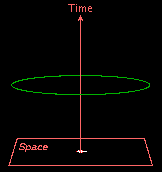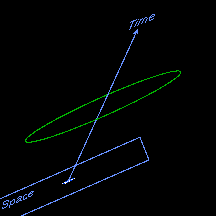As I understand it, extra dimensions in physics are simply a mathematical construct to solve problems. This is a very powerful way to solve complicated systems, and also to come up with new theories.
One example I like to give: the
Kepler problem.
Newton became famous when he showed that, assuming that the gravitational force is of the form 1/r^2, the orbits of the planets around the sun form ellipses with the sun at one of the centers. A proof of this is given in most introductory physics courses.
Another proof that can be written goes like this: for the 1/r^2 force you can write a
vector that's conserved by the motion. From this conservation property, it's not very hard to show that the planet's orbit is an ellipsis.
Also, in the (non-relativistic) hydrogen atom, where the force is also 1/r^2, the s, p and d orbitals all have the same energy, and this property is only true if the force goes with the inverse of the square radius, for all others it does not work.
When confronted with this observation, there are two possible attitudes:
A) You don't care, you already have a set of equations that describe the physics of the phenomenon you want. If all you want is to compute predictions from the theory, the problem is already solved, and you can use the formalism you want.
B) You want to know *why* the 1/r^2 force is so special, why it conserves such an exotic vector and makes the energy levels for different states in hydrogen agree.
If your attitude is in line with (B), then going to extra dimensions gives you an explanation.
It turns out that the motion of a particle subject to a force that goes like 1/r^2 is completely equivalent to the motion of a free particle on the "surface" of a "sphere" on four-dimensional space.
That is, if you have four space coordinates x,y,z,w, and study the movement on a space that satisfies x
2+y
2+z
2+w
2=1, what we call a
3-sphere, you can transform the solution to a movement in 3-dimensional space under the force 1/r^2!
Although it's a bit abstract, you can see where the strange properties come from. The ordinary sphere has some symmetries, you can roll it in different ways so that it stays the same. The 3-sphere has more symmetries than the ordinary sphere does, so the conservation of the LRL vector in classical mechanics, and the s and p orbitals having the same energy in quantum mechanics are simply artifacts of this extra symmetries, which are very hard to see in the ordinary space, but obvious in the 3-sphere.
So, one exotic way of solving this problem would be: take four very weird variables from the problem, construct a four-dimensional Euclidean space from it, and check that the problem is just a free particle, then transform the solution back to ordinary space and find the answer.
If your attitude is (A), when presented with this solution, you'll think it's a huge waste of time. Why construct weird geometric spaces, study their symmetries, just to solve a problem that can be destroyed with ordinary calculus? You gained no new insight into it.
However, it's often the case that physicists need to generalize their theories because the current ones they have are not good enough, and this kind of understanding can lead to new insights. For example, you could try different geometries and see what kind of forces you can solve. The solutions you will find would be very difficult to find otherwise.
Using time as a fourth dimension is a similar story. You can write relativity considering space and time as separate entities, no problem. Once you have all the equations, if you can solve them, no errors will happen. However, it just happens that if you construct a four-dimensional spacetime, the formulas can be derived elegantly from geometric properties.
About the question whether these "dimensions" are real, I leave it for the reader. Many people would say that spacetime is "real", because the equations of relativity are more elegant on it. By the same argument, the 4-dimensional space in the hydrogen atom would also be "real" because the equations are also more elegant. For this reason, I prefer to treat it as a convenient mathematical abstraction.
P.S.: This trick of working on higher dimensions to search for theories in lower ones is a common pattern in modern physics. For anyone who's interested, a classic case is general relativity on five-dimensions with the fifth curled up on a cylinder, which is equivalent to
gravity+eletromagnetism.
In the
worldline formalism, all particle interactions can be derived by curling up extra dimensions to implement the forces of nature.
Also, it's conjectured that string theory compactified on a
Calabi-Yau manifold, a 6-dimensional space with some exotic properties, gives all forces of nature, including gravity.

















 Red represents the simultaneity surfaces (the 3d-slice) of one frame, while blue represents simultaneity surfaces of another frame moving at a constant velocity from it. Notice that the 3d-slice of blue is tilted with respect to red, so these surfaces are different.
The fundamental physical property that we cannot "see" into the past is called causality. But notice that the notion of causality is very different in relativity, because simultaneity depends on the observer.
The resolution of this apparent paradox is resolved by classifying the separation of spacetime events in three categories:
* lightlike events, which are connected by a ray of light
* timelike events, which are separated by a time interval in some frame
* spacelike events, which are separated by a space interval in some frame
It turns out that only timelike events can have a causality relation. Intuitively, that means that if a star A exploded at a point X and time T, and another one at a point X' and at a future time T', it's possible that the first explosion caused the second only if the separation between these events is timelike (which is just a fancy way of saying that they are close enough so that you can travel between them slower than the speed of light).
Geometrically, that implies the following figure, which we call the light cone:
Red represents the simultaneity surfaces (the 3d-slice) of one frame, while blue represents simultaneity surfaces of another frame moving at a constant velocity from it. Notice that the 3d-slice of blue is tilted with respect to red, so these surfaces are different.
The fundamental physical property that we cannot "see" into the past is called causality. But notice that the notion of causality is very different in relativity, because simultaneity depends on the observer.
The resolution of this apparent paradox is resolved by classifying the separation of spacetime events in three categories:
* lightlike events, which are connected by a ray of light
* timelike events, which are separated by a time interval in some frame
* spacelike events, which are separated by a space interval in some frame
It turns out that only timelike events can have a causality relation. Intuitively, that means that if a star A exploded at a point X and time T, and another one at a point X' and at a future time T', it's possible that the first explosion caused the second only if the separation between these events is timelike (which is just a fancy way of saying that they are close enough so that you can travel between them slower than the speed of light).
Geometrically, that implies the following figure, which we call the light cone: